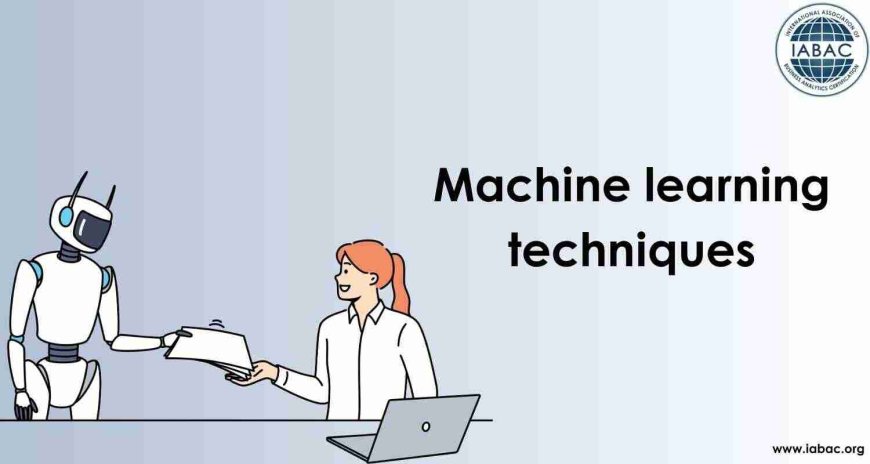Machine learning techniques
Machine learning techniques involve algorithms enabling computers to learn from data, make predictions, and improve performance over time.

Machine learning techniques are a set of computational methods that enable machines to learn from data and improve their performance without being explicitly programmed. Rooted in artificial intelligence, these techniques empower systems to recognize patterns, make decisions, and adapt to new information. By leveraging algorithms and statistical models, machine learning has found application in diverse fields, ranging from healthcare and finance to marketing and transportation. The essence of these techniques lies in their ability to analyze data, identify trends, and generate insights, contributing to more informed decision-making processes. As technology continues to advance, the refinement and application of machine learning techniques play a pivotal role in addressing complex challenges and unlocking new possibilities across various industries.
What is Machine Learning?
Machine Learning (ML) is a subfield of artificial intelligence (AI) that focuses on developing algorithms and models capable of learning and improving from data. Unlike traditional programming, where explicit instructions are provided, ML systems are designed to learn patterns and make predictions or decisions based on input data. The essence of machine learning lies in its ability to recognize patterns, adapt to new information, and refine its performance over time.
The overarching goal is to enable machines to learn from experience, ultimately enhancing their ability to perform tasks without being explicitly programmed for each specific scenario. Machine learning finds applications in various domains, ranging from predictive analytics and image recognition to natural language processing, contributing to advancements in technology and reshaping the way we approach problem-solving.
How does machine learning work?
Machine learning is a subset of artificial intelligence (AI) that focuses on developing algorithms and models that enable computers to learn from data and improve their performance on a specific task without being explicitly programmed. The core idea behind machine learning is to allow systems to automatically learn and adapt from experience.
1. Data Collection
The process begins with the collection of relevant data. This data could be anything from images and text to numerical values, depending on the type of task the machine learning model is designed to perform. The quality and quantity of the data play a crucial role in the effectiveness of the model.
2. Data Preprocessing
Once the data is collected, it often needs to be cleaned and prepared for analysis. This may involve handling missing values, normalizing data, and converting it into a format suitable for the chosen machine learning algorithm.
3. Choosing a Model
There are various machine learning algorithms, and the choice of the algorithm depends on the nature of the problem and the type of data available. Common types of machine learning algorithms include supervised learning (where the model is trained on labeled data), unsupervised learning (where the model discovers patterns in unlabeled data), and reinforcement learning (where the model learns through interaction with an environment).
4. Training the Model
In the training phase, the selected algorithm is fed with the prepared data. During this process, the model adjusts its internal parameters to learn the patterns and relationships within the data. The goal is for the model to make accurate predictions or classifications based on the input it receives.
5. Evaluation
After training, the model needs to be evaluated to ensure its effectiveness. This is typically done using a separate set of data that the model has never seen before (testing data). The model's performance is assessed based on its ability to make accurate predictions or classifications.
6. Fine-Tuning
Based on the evaluation results, the model may be fine-tuned to improve its performance. This process may involve adjusting hyperparameters, adding more features, or retraining the model with additional data.
7. Prediction or Inference
Once the model is trained and evaluated satisfactorily, it is ready for making predictions or inferences on new, unseen data. The model applies the patterns it has learned during training to make predictions or classifications without explicit programming.
It's important to note that the success of a machine learning model is highly dependent on the quality of data, the appropriateness of the chosen algorithm, and the careful tuning of parameters. Machine learning is a dynamic field with continuous research and development, leading to the creation of more sophisticated algorithms and techniques over time.
Types of Machine Learning Techniques
Machine Learning (ML) is a subfield of artificial intelligence (AI) that focuses on developing algorithms and models that enable computers to learn and make predictions or decisions based on data. There are several types of machine learning techniques, each with its own characteristics and applications. Here, we'll explore three fundamental categories: supervised learning, unsupervised learning, and reinforcement learning.
1. Supervised Learning
Supervised learning is one of the most common types of machine learning techniques. In this approach, the algorithm is trained on a labeled dataset, where each input is associated with the corresponding output. The goal is for the algorithm to learn the mapping from inputs to outputs so that it can make accurate predictions on new, unseen data.
Example: A classic example of supervised learning is classification, where the algorithm learns to categorize inputs into predefined classes. For instance, it can be trained to recognize spam emails versus non-spam emails based on labeled examples.
Applications: Supervised learning is widely used in tasks such as image recognition, speech recognition, and predicting numerical values (regression).
2. Unsupervised Learning
Unsupervised learning involves training algorithms on unlabeled data, to identify patterns, relationships, or structures within the data. The algorithm explores the data without specific guidance on what to find, making it well-suited for discovering hidden insights.
Example: Clustering is a common unsupervised learning task. The algorithm groups similar data points together without prior knowledge of their labels. This can be applied, for example, in customer segmentation for targeted marketing.
Applications: Unsupervised learning is used in anomaly detection, dimensionality reduction, and clustering for organizing data into meaningful groups.
3. Reinforcement Learning
Reinforcement learning involves training algorithms to make sequences of decisions by interacting with an environment. The algorithm receives feedback in the form of rewards or penalties based on the actions it takes, and its goal is to learn a strategy that maximizes the cumulative reward over time.
Example: In reinforcement learning, an algorithm might learn to play a game by receiving positive rewards for winning and negative rewards for losing. Over time, it adapts its strategy to maximize the cumulative reward.
Applications: Reinforcement learning is applied in areas such as game playing, robotic control, and autonomous systems where agents need to make a series of decisions to achieve a goal.
These three types of machine learning techniques form the foundation for a wide range of applications across various industries. Depending on the nature of the problem and the available data, practitioners choose the most suitable technique or combination of techniques to develop effective and efficient machine learning models.
Machine learning techniques, rooted in artificial intelligence, empower systems to learn, adapt, and make informed decisions without explicit programming. From supervised learning's categorization prowess to unsupervised learning's pattern discovery and reinforcement learning's sequential decision-making, these techniques revolutionize diverse fields. As technology advances, the careful application and refinement of machine learning techniques play a pivotal role in addressing complex challenges and unlocking new possibilities across industries.











































